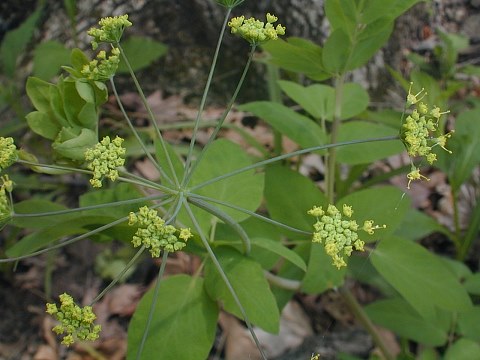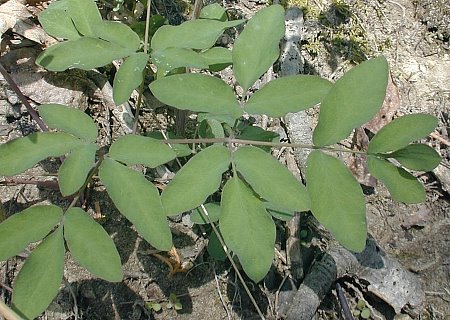Description: This herbaceous perennial plant is 1-3' tall, branching sparingly. The stems are round, hairless, and dull green to reddish brown. They may be slightly glaucous. The larger leaves are doubly compound, while the smaller upper leaves may be singly compound. They are arranged alternately along the stems. In each compound leaf, the leaflets form groups of three (trifoliate). A lower compound leaf may be 12" long and 6" across, while the upper compound leaves are much smaller. There is a sheath at the base of each compound leaf. A typical leaflet is about 1" long and ½" across. It is dull green with a smooth surface and edges, and oval, ovate, or oblanceolate in shape. The terminal leaflet has a conspicuous petiole, while the side leaflets are usually sessile, or nearly so. Some of the upper stems terminate in compound umbels of tiny yellow flowers. When fully mature, a compound umbel will span about 4-7" and consist of about 12-15 umbellets. The umbellets will be widely spaced, giving the compound umbel and airy appearance. Each umbellet will consist of about 12 flowers. Each flower is less than 1/8" (3 mm.) across and has 5 yellow petals. The blooming period occurs during late spring or early summer and lasts about one month. There is no noticeable floral scent. Each flower is eventually replaced by a 5-angled fruit. The root system consists of taproot.

Cultivation:
The preference is partial sun and dry conditions. Poor soil is
preferred, consisting of clay, rocky material, or some sand, as this
reduces the competition from other plants. This plant adapts well to
slopes, although it may not remain very erect. Disease doesn't appear
to disfigure the foliage very often. Drought resistance is very good.
Range & Habitat:
The native Yellow Pimpernel occurs occasionally in northern and central
Illinois,
but is uncommon or absent in southern Illinois (see Distribution
Map). Habitats include dry upland prairies, edges of hill
prairies, upland savannas, rocky upland forests, bluffs, areas along
woodland paths, eroded clay banks in semi-shaded areas, and thickets.
This plant typically occurs at the edge of dry wooded areas, especially
where slopes occur.
Faunal Associations:
The flowers attract small bees, wasps (including parasitic wasps),
flies, and beetles. These insects seek nectar primarily, although some
bees may collect pollen and some flies and beetles may feed on pollen.
Some of the fly visitors include Syrphid flies, Tachinid flies,
Chloropid flies, March flies, and Blow flies, while bee visitors
include Nomadine bees, Little Carpenter bees, Halictid bees, Carder
bees, and Andrenid bees. The caterpillars of the butterflies Papilio
polyxenes asterias (Black Swallowtail) and Papilio
joanae (Ozark Swallowtail) feed on the foliage of this plant;
the latter insect has not been observed in Illinois, although it has
been found in Missouri and western Kentucky. Little information is
available about this plant's relationships to birds and mammals as a
possible food source.

Photographic
Location: The photographs were
taken along a path in an upland woodland near Charleston, Illinois, and
at the edge of a hill prairie in
Vermilion County, Illinois.
Comments:
Among members of the Carrot family, Yellow Pimpernel has an unusual
appearance because the leaflets lack any lobes or teeth. This makes the
species easy to identify in the field. Also, the compound umbels are
unusually open and airy in appearance. This member of the Carrot family
is rarely seen in cultivation, but should be grown more often as the
tiny flowers attract many beneficial insects.